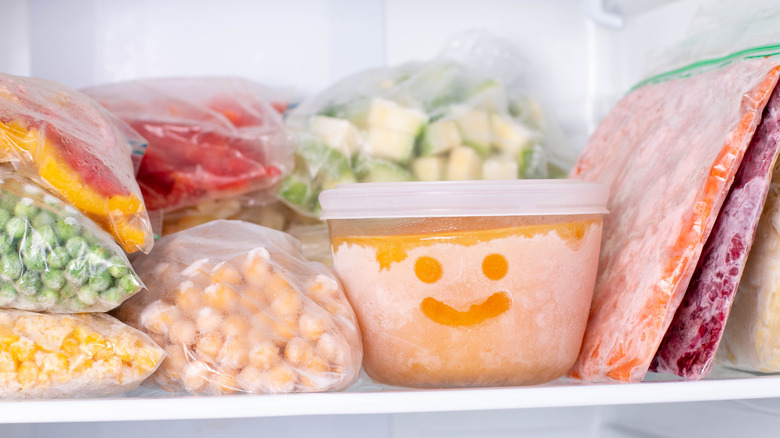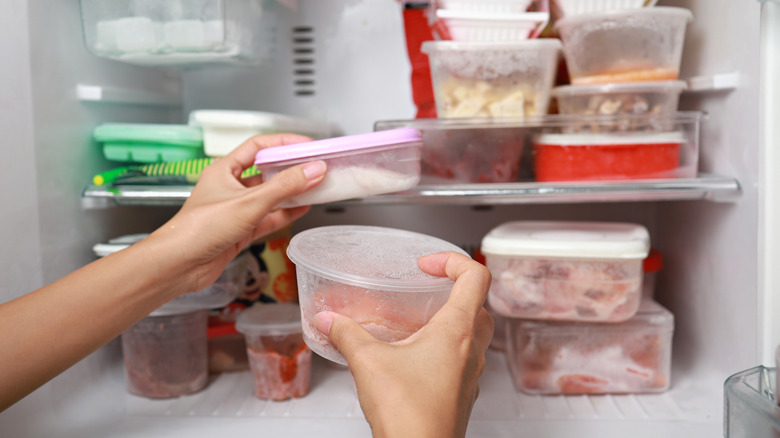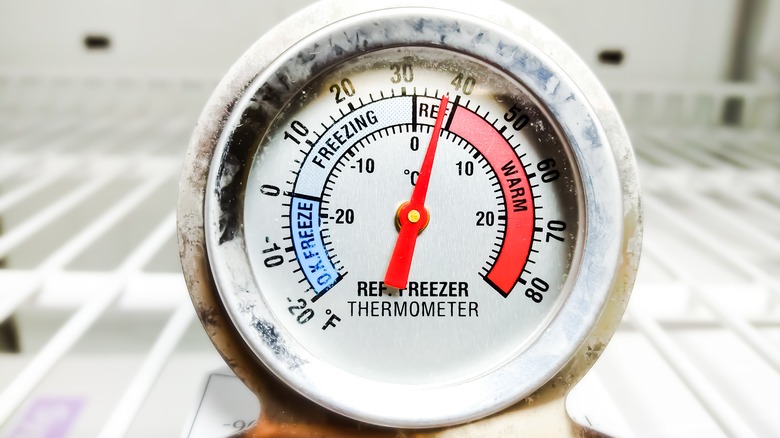Here's How Long Frozen Food Will Last In A Power Outage
While frozen food may date back thousands of years, freezers are a modern invention. Unfortunately, natural disasters from earthquakes and hurricanes to fires and floods can cause the power to go out. Heat waves and extreme weather can overload power grids, resulting in rolling brownouts or blackouts. It's important to know how long frozen food will last during a power outage, so that when the lights do come back on, you will know if your food is still safe to eat. Along with the financial loss of a freezer full of spoiled food, eating food that has gone bad can make you and your family sick, creating a whole other type of emergency. This can be avoided by following frozen food safety guidelines and planning ahead.
According to the CDC, when a power outage occurs, food will last "48 hours in a full freezer; 24 hours in a half-full freezer." The caveat is that the doors must remain closed to keep the cold air in and the warm air out.
We turned to the nation's top food, health, and safety agencies for more information on how long food can stay safely frozen during an electrical outage. The CDC (Centers for Disease Control and Prevention), the USDA (U.S. Department of Agriculture), and the FDA (United States Food and Drug Administration) all agree on the basic steps that should be taken before, during, and after a power outage to help food stay frozen as long as possible and to prevent food-borne illnesses. The first step is to get prepared ahead of time because things like meat that haven't been thawed in the best, safest way can cause illness.
How to keep food frozen when the power goes out
Before the next power outage, purchase appliance thermometers to place in both your freezer and refrigerator. Freezers should always be kept at 0 degrees Fahrenheit or below, and refrigerators need to be 40 or below. When the power does come back on, the thermometers will come in handy for checking if food has remained at cold enough temperatures to be consumed.
Keeping your freezer full will help maintain a stable temperature. You can fill in open spaces by freezing water bottles, gel packs, and ice bags. Keep frozen foods bunched together to maximize how long they will stay cold. You can also move perishables from the refrigerator into the freezer before the power goes, both to fill the freezer and to keep those foods at safer temps. Plan for longer power outages by knowing where you can purchase dry ice or ice blocks near you. These can be used to keep the freezer cold for longer.
Freezer doors need to remain closed so that the frozen food inside will last the full 48 hours (two days). Without electricity, food will first begin to defrost at the top, front, and doors of the freezer — as will food in smaller, flatter containers. Items kept at the back, on the bottom, or that are in bigger, thicker packaging will stay frozen longer. So, frozen smoothie packs kept in the door will thaw more quickly than a large, frozen turkey kept on the freezer's bottom shelf.
As the CDC writes: When in doubt, throw it out!
Once the electricity has been restored, you will need to determine if your frozen foods have remained safe to eat. An important rule from the CDC, USDA, and FDA is to never take a small bite to see if it's still good. Rotten food may not always show visible signs of having gone bad.
If an appliance thermometer is present, make sure the freezer's temperature has not gone above 40 degrees. Food that has thawed slightly but is still cold with ice crystals is safe to eat. At this temperature, it is also safe to refreeze (though quality may be affected and cause freezer burn).
Foods deemed to be safe should be cooked thoroughly before eating to kill off any bacteria. Perishable foods that have dropped to below 40 degrees in the freezer or have been in the refrigerator for longer than four hours without power need to be discarded. These include dairy, eggs, meat, chicken, and fish, as well as home-cooked or restaurant leftovers. Foods that have developed any unpleasant odors, off colors, strange textures, or visible mold must be thrown away, too. When checking to see if your food has stayed frozen through a power outage, it is crucial to follow one more rule emphasized by the three safety agencies — "when in doubt, throw it out!" To avoid getting or spreading an illness, it's best to dispose of any foods you are unsure of. This is one situation where it's definitely better to be safe than sorry as a trip to the doctor will outweigh the lost groceries.



